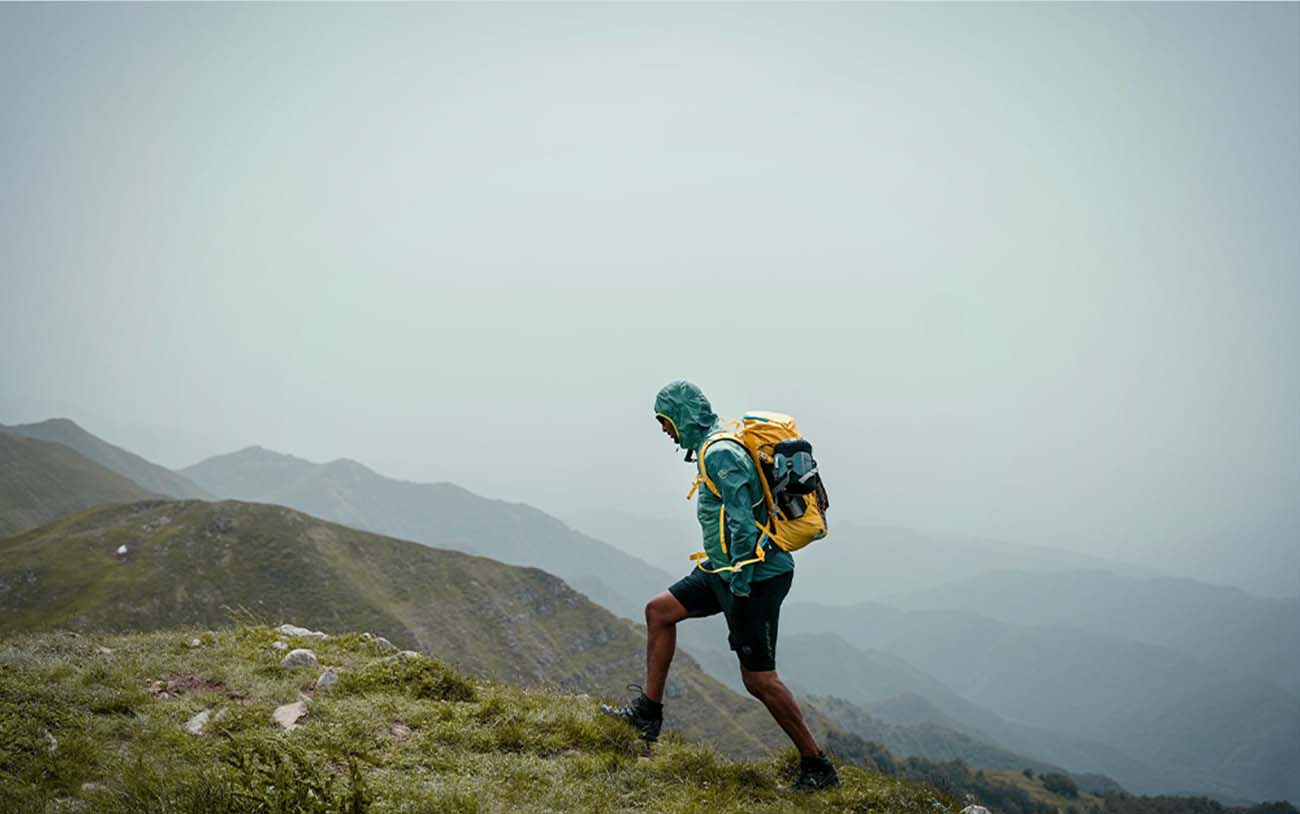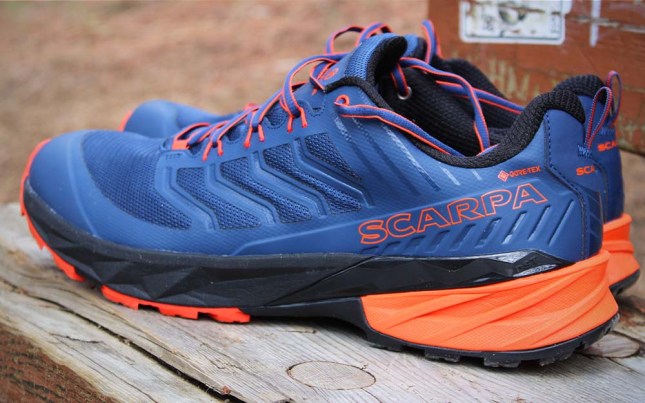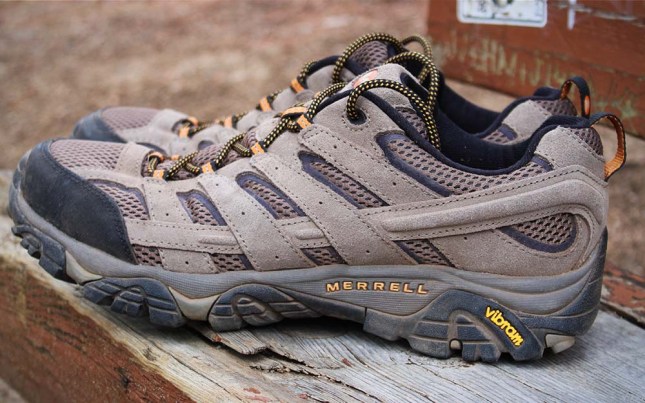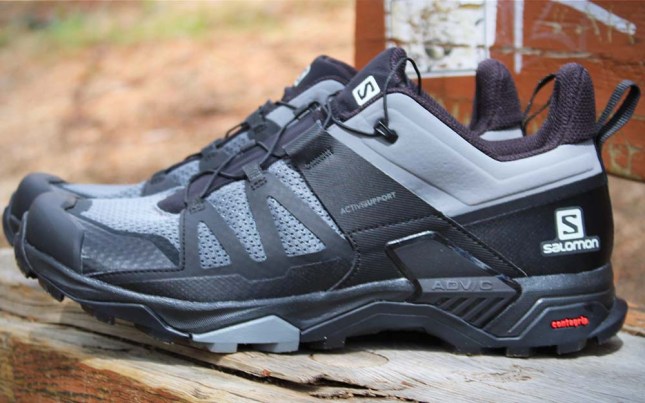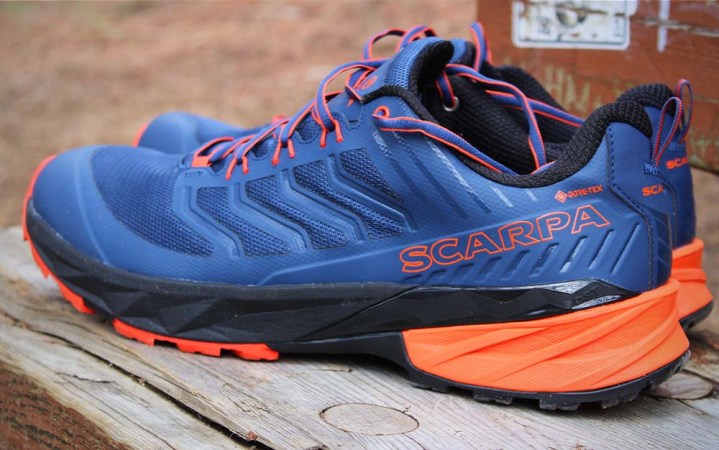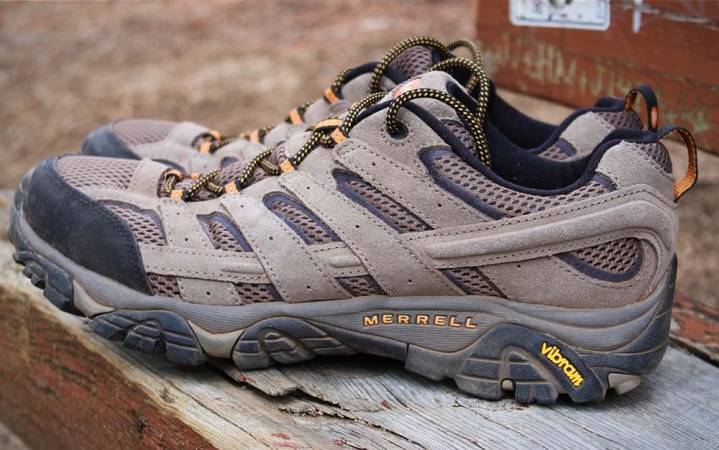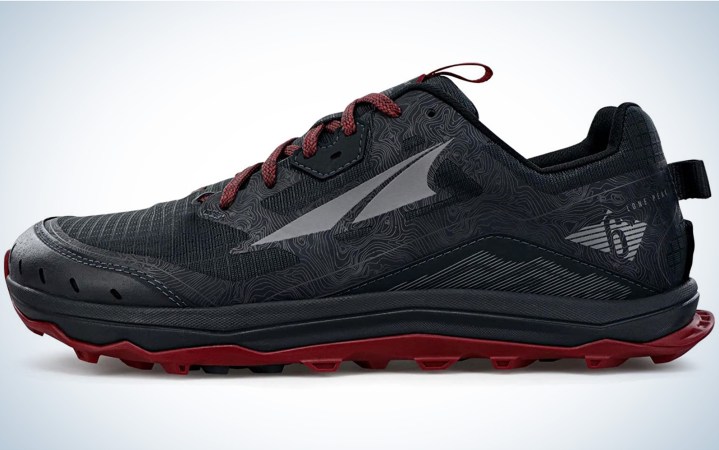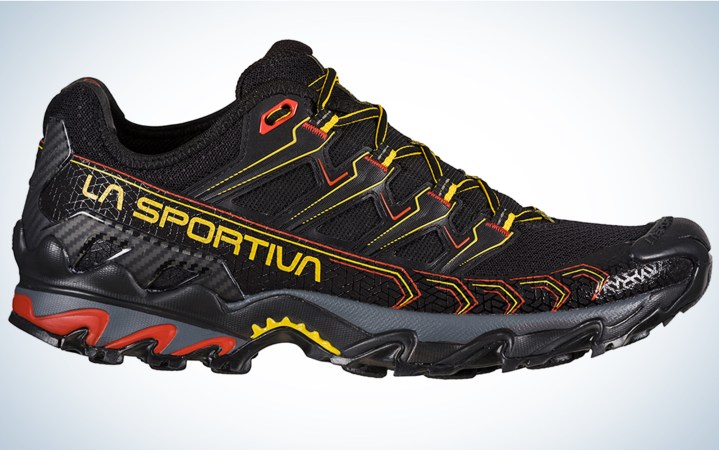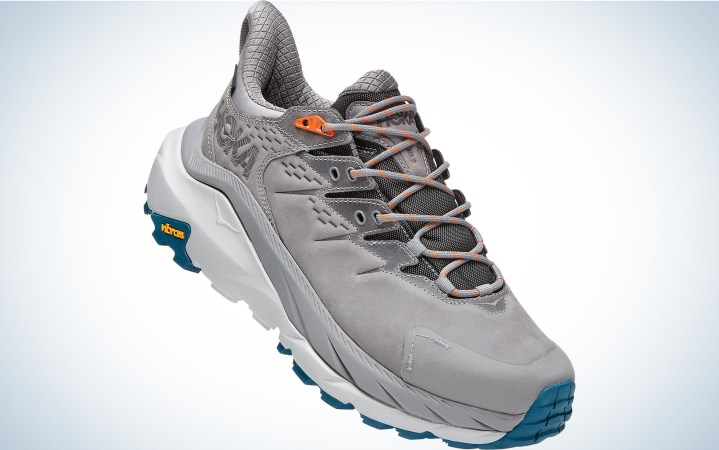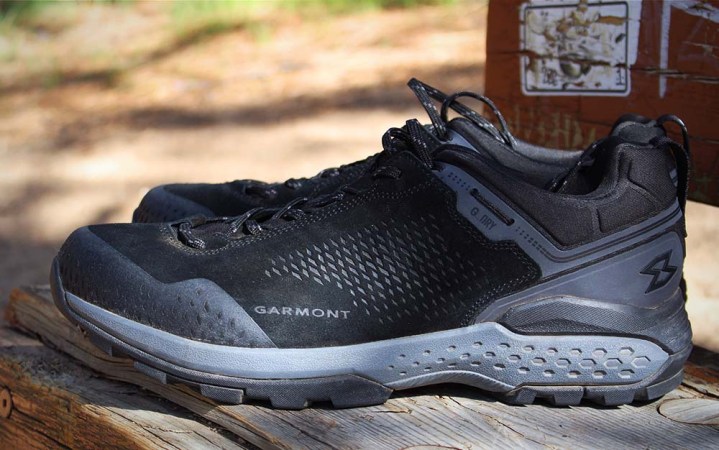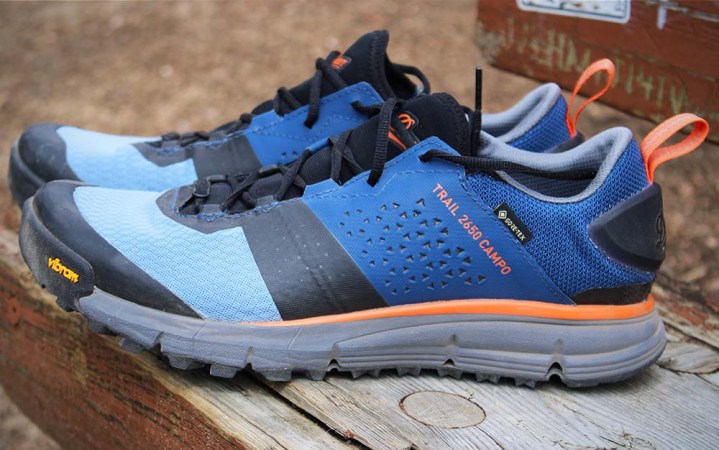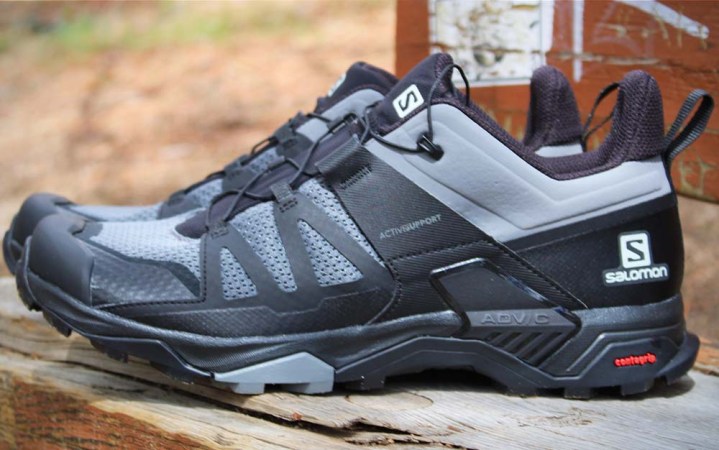We may earn revenue from the products available on this page and participate in affiliate programs. Learn More ›
Hiking is the root of many outdoor activities, and the top men’s hiking shoes are going to help you go farther faster. They’ve replaced big, rugged boots for hikers who find boots overkill for trails or plan to pick up the pace.
If you’re looking to replace your heavy boots with something lighter, you’ll need to sort through the wide range of options, fits, and specialties of hiking shoes. I’ve turned that uphill march into a walk in the park by testing the best options on the market on my local Colorado trails. After putting miles on these shoes and evaluating their fit, traction, features, and support, I made my top picks for the best men’s hiking shoes.
- Best Overall: Scarpa Rush GTX
- Most Comfortable: Merrell Moab 3
- Best Trail Runner: Altra Lone Peak 6
- Best for Mixed Terrain: La Sportiva Ultra Raptor ll
- Best Lightweight: Hoka Kaha GTX 2
- Best Support: Garmont Groove G-Dry
- Best for Trail and Town: Danner Trail 2650 Campo GTX
- Best Waterproof: Salomon X Ultra 4
How I Chose the Best Men’s Hiking Shoes
I used my years of hiking knowledge to head into the Northern Colorado mountains on a mix of aggressive trails and paths—including creek crossings—to get a good take on what made the best men’s hiking shoe and what other unique aspects made other shoes stand out. I tested them with a series of steps including:
- Hiking: I started out each shoe with a short hike to give it some time to break them in. I then followed up with a longer hike that covered up hills and flat sections to get a good feel for the shoes.
- Water crossings: I made sure to spend sometime crossing wet rocks and downed trees, while also occasionally getting some shoes fully into the water to see if they kept my feet and socks dry.
- Sizing: With so much shopping done online, it’s important to get a good idea for a fit. As a size 11, some shoes felt a little too loose while others left no room in the toe box. As with most hiking shoes, having a gap between your toe and the front of the shoe is essential for hiking downhills.
- Uniqueness: I also made sure to test out anything that made a shoe unique to highlight what each hiking shoe was designed for—this included waterproof hiking shoes, alternative laces, and other qualities.
Best Men’s Hiking Shoes: Reviews & Recommendations
Best Overall: Scarpa Rush GTX
Key Features
- Designed for day hikes and trail running
- Waterproof to keep you going
- Weight: 1 pound, 10 ounces
Pros
- Great for fast hikers
- Extra padded soles to keep feet comfortable
- Designed to keep water out and to keep you moving on trail
Cons
- Most users will need to size up
- Not as breathable as someone other options
It might be surprising that trail runners are the best men’s hiking shoes, but more hikers are adopting this shoe style, myself included. I consider myself a fast hiker when I’m backpacking. I recently hiked 30 miles on a two-day trip. Often on trail, I bring trail runners, and Scarpa Rush fills that need. I found them to be a great version of a hiking shoe for those who move swiftly through rugged trails and like to keep moving.
There was also additional support in a thicker sole than you would find in a traditional trail runner, making this a great hybrid for anyone looking for an all-around shoe. Plus, the shoe did a great job of keeping water out while creek crossing yet still being breathable with its GORE-TEX design. One thing to note is the Scarpa Rush runs fairly tight. I usually wear an 11, and my toes were right up against the toe box in these 11s.
Most Comfortable: Merrell Moab 3
Key Features
- Offers extreme cushion
- Vibram soles
- Weight: 2 pounds
Pros
- Affordable with lots of variations to fit your needs
- Sticky sole helps handle slick and wet rocks
- Felt broken in right out of the box
Cons
- With the added comfort comes a bulkier design and an overall wider looking shoe
- Did begin to feel sore after about ten miles
Slipping on the Moab, my most comfortable hiking shoe pick, felt like a cloud compared to some other brands. I noticed immediate comfort from the Moab’s cushioned design. The Moab 3 also handily dealt with rocky trails and roots in the Rocky Mountains, and with a Vibram sole, you can count on many miles and a rubber that’s sticky enough to handle slick terrain and rocks. Once I started pushing miles in these shoes, it eventually felt like a strain on my foot, so maybe these are best designed for the casual day hiker.
I also tried a few other Moab variations Merrell offers, including the waterproof version. It’s an excellent option for anyone who does a lot of creek crossing, casual fly fishing, or lives in a wet area. The sticky rubber also made it great for river crossing and overall kept my feet fairly dry as I crossed a few small creeks. You can also go with the Mid GTX (Gore-Tex) that takes the Moab design and makes it into a boot. Overall, I found it had the same comfort and strong attributions as the shoe, with added ankle support.
Best Trail Runner: Altra Lone Peak
Key Features
- Available in wide
- Weight: 22 ounces
- Zero drop
- Includes a rock plate
Pros
- Lightweight
- Zero drop for runners
Cons
- Minimal cushioning and arch support
If you’re looking to switch up your footwear, whether it be for hiking, trail running, or hunting, then it’s worth putting the Altra Lone Peaks onto your short list. Runners may discover that they naturally change their gait in footwear that promotes a mid-foot or forefoot strike, with subsequent benefits in their running form, knee pain, or both. One thing to note is that there is minimal support, particularly arch support in this shoe, so some runners may need to add in a custom insole, such as from Superfeet, to compensate.
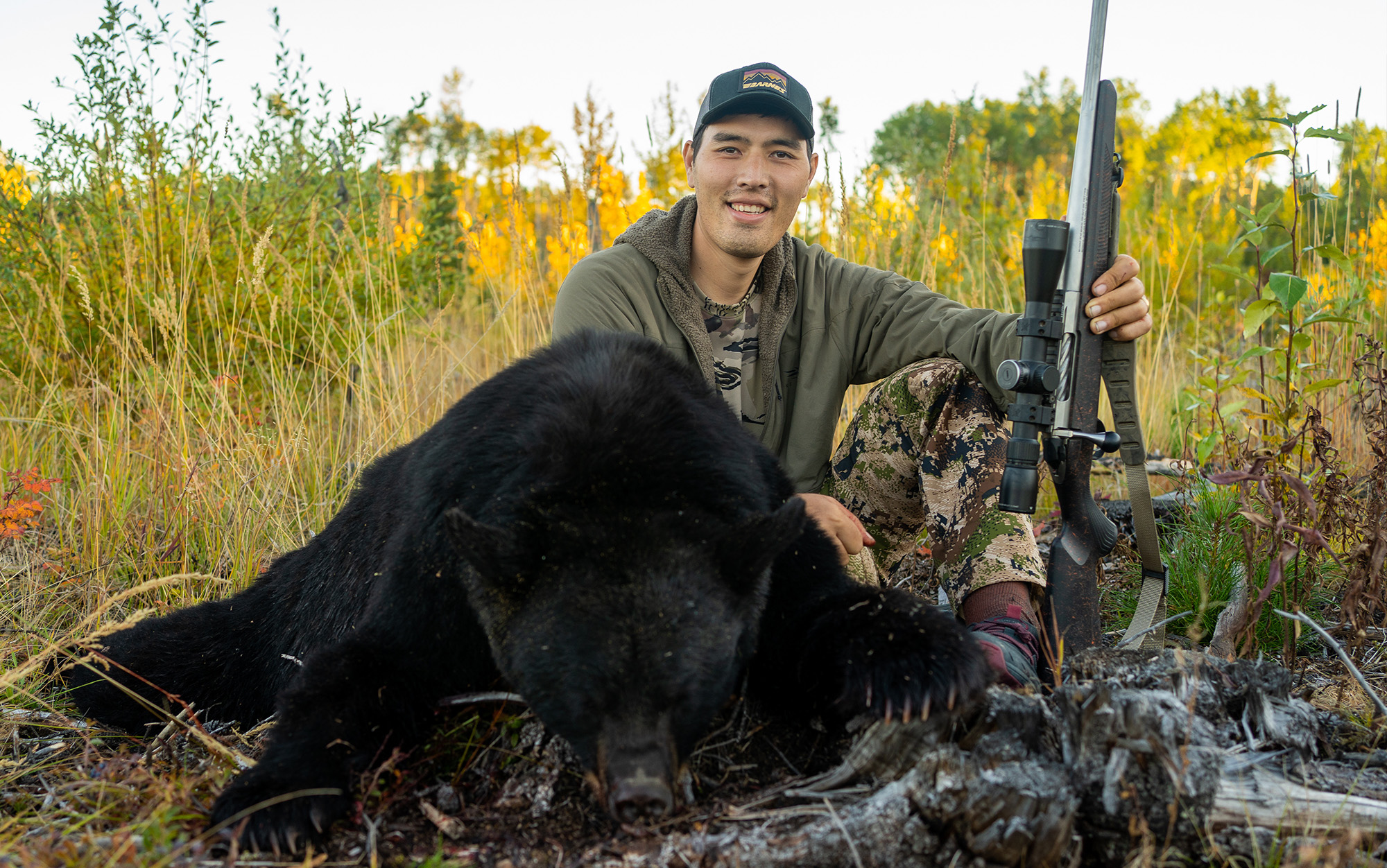
These are some of the few true zero-drop shoes on the market that also provide a level of underfoot cushioning. The wide toebox helps to improve stability while hiking, especially over uneven terrain. Individuals looking to ease their way into true minimalist footwear should consider this as an in-between shoe that will allow their foot (particularly their arch) to strengthen after years of wearing more traditionally supportive shoes.
Best for Mixed Terrain: La Sportiva Ultra Raptor ll
Key Features
- Gore-Tex extended comfort waterproof and breathable linings
- Can be resoled
- Weight: 1 pound, 11.5 ounces
Pros
- Breathable hiking shoes
- Waterproof
- Thick rubber toe cap
Cons
- Pricey
This shoe bridges the gap between a trail runner and scrambler. It’s ready for unexpected weather, but without added weight and bulk. The outsole has one set of raised oval-shaped lugs that grip dirt and rock, as well as another set of lugs for stability by biting into the terrain for push off. The center of the insole has a deep cup with two big lugs on the back end that act as a braking system for hard stops or descending a steep slope.
The shoe is wrapped in an abrasion-resistant breathable mesh that is tough against rocks and sticks and does not allow in small debris. The toe of the shoe is reinforced by a huge rubber cap that absorbs impact and tackles obstacles in the terrain. I do worry that because the rubber is not flush with the shoe it could peel back over time, but it has yet to happen.
As for weather protection, the whole shoe is wrapped in Gore-Tex to keep your feet dry at all times. A simple, but secure, lacing system with one eye hook keeps the shoe snug. The heel does not have a pull loop, but rather a fold in the material that allows you to get a finger in to pull the shoe on. —Justin La Vigne
Best Lightweight: Hoka Kaha GTX 2
Key Features
- Available Sizes: 7-15
- Weight: 2 pounds
- Price: $240
Pros
- Lightweight
- High ankle support
- Cushy footbed
Cons
- Expensive
- No wide options
The design of the sole of the Kaha GTX has a very slight arch, which creates a rocking motion to spring my steps forward. I feel a bounce in my steps along with the enhanced cushion. Released just last year, the GTX 2 has a more plush cushion and my feet never ached or fatigued. The newest GTX also utilizes more sustainable materials, like recycled Gore-Tex textiles. These are one of the few pairs of shoes that I don’t feel I need to replace the insole with aftermarket versions because of the ideal shock absorption.
I tramped through wet and muddy swamps and the Gore-Tex lining kept my feet completely dry. Comprised of Vibram Megagrip, the multi-directional rubber lugs of the outsole gripped well and kept me moving forward. If there are any downsides, it’s been my experience that after extensive use — especially after hiking on sharp lava rock — the outsoles do wear down faster than other shoes I’ve tested. —Justin La Vigne
Best Support: Garmont Groove G-Dry
Key Features
- G-Dry tech is waterproof and windproof and keeps your foot dry
- Sturdy middle foot for those who want extra support
- Weight: 2 pounds
Pros
- Good hiking shoes for rocky terrain
- Waterproof adds confidence in creek crossing
- Sturdy for those who need extra support
Cons
- A fairly narrow shoe, so you may need to size up
- If you care about your shoes looking new, that won’t last long as the black leather exterior is like a magnet for dirt
Out of the box, the Garmont Groove G-Dry lives up to its sturdy design. I took these on a fairly aggressive uphill trail in Roosevelt National Forest, and it took a bit of walking before I could feel my feet getting used to them. I prefer fairly flexible footwear, so it took a minute to get used to the Groove’s stiffness. However, the Groove may be a great option for anyone looking to get the extra support of a boot in a shoe.
This best men’s hiking shoe also does a great job of keeping things dry, as I found when I tested it around the Poudre River. One con is the all-black design does attract plenty of dirt, so you’ll have to rinse them off to keep them looking pristine.
Best for Trail and Town: Danner Trail 2650 Campo GTX
Key Features
- Breathable lightweight design
- Vibram soles
- Weight: 2 pounds
Pros
- A unique design with a sock-like fit you slip your foot into
- Very breathable hiking shoe
- Great grip and handling of trails
Cons
- One of the pricier options
- Takes a bit to get used to the fit and may be a little loose
The first thing I noticed with the Danner Trail 2650 is they look cool. I have a pair of blue ones, and they look like you can wear them just about anywhere.
Aside from looking the part, Danner also uses the Vibram sole for great grip. While the actual shoe is thin and breathable, I found it had extra reinforcement where you need it, like on the toe box, which is helpful on rocky trails. The GORE-TEX material also helped keep my feet dry from outside water while allowing for breathability and avoiding sweaty feet. I would recommend sizing down these men’s hiking shoes in some cases as I felt a little bit of wiggle room, especially around the heel.
Best Waterproof: Salomon X Ultra 4 GTX
Key Features
- Gore-Tex waterproof shoe
- Weight: 1 pound, 11 ounces
Pros
- Does great handling water and kept my feet dry
- Lightweight compared to some competition
Cons
- Traction didn’t feel as good as the brands using Vibram rubber
- Opting to not use traditional laces can take getting used to for the right fit
Many hiking shoes use Gore-Tex technology, and to test them, it was easiest to just hike right into a river. I will say, out of all of them, the Salomon X Ultra 4 GTX kept my feet the dryest. In the water the grip also held up close to competitors who used the Vibram rubber.
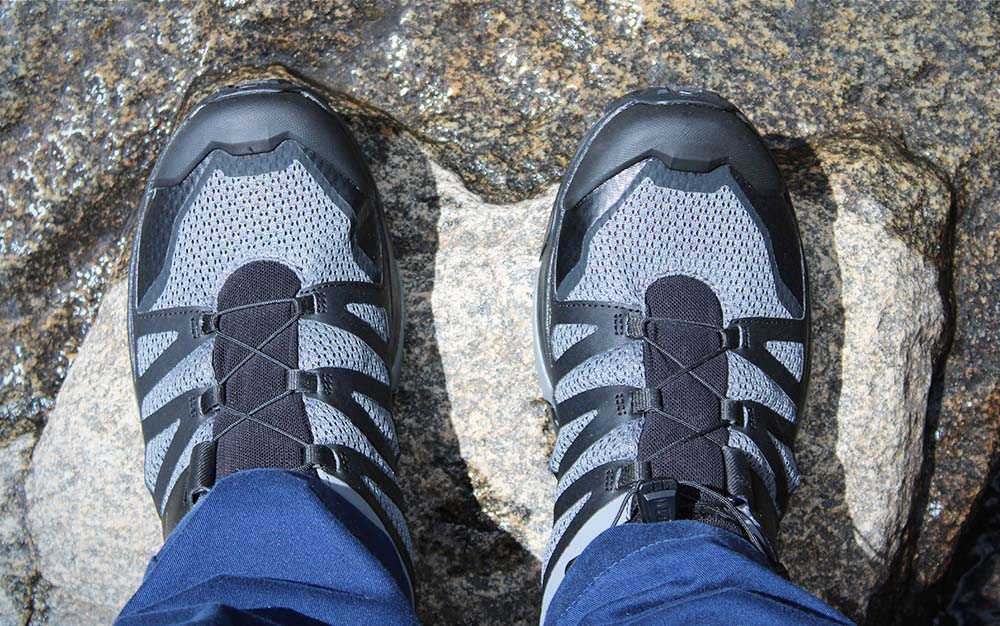
Instead of traditional laces, the shoes have a SensiFit system that works like a drawstring. While many may like this feature for its snug fit, it took me time to get used to it and optimize the feel for my feet. The sizing is also true to size and the shoe felt good to go right out of the box.
How to Choose the Best Men’s Hiking Shoes
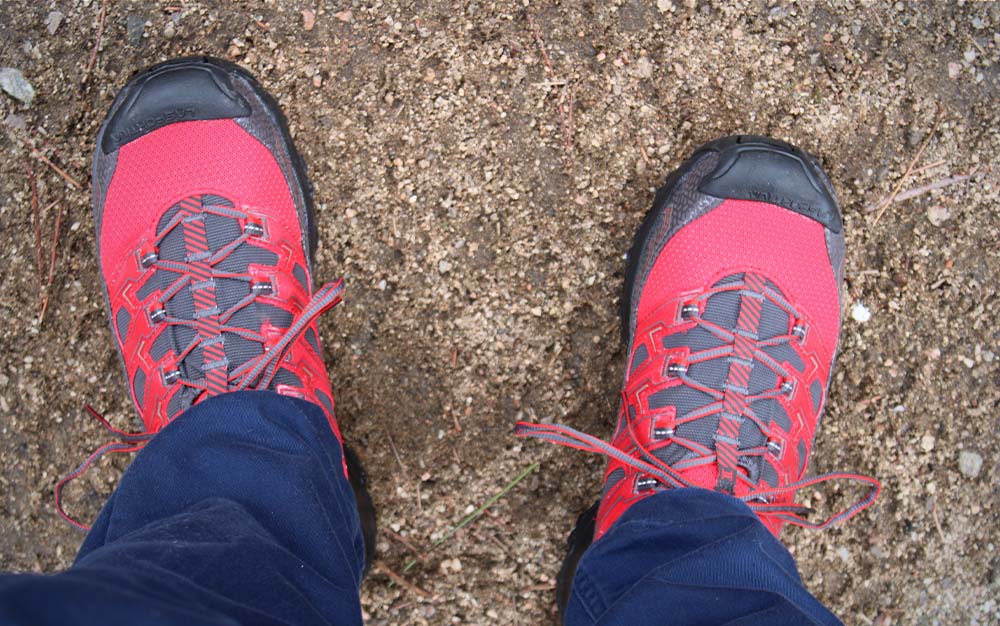
There is a lot that goes into picking the best hiking shoes. Luckily, a few simple steps can make sure you find the perfect fit to avoid injury and find what works best for you.
Starting with what might be obvious, but can be overlooked, hikers need to examine their own feet. Cramming wide feet into a thin shoe leads to blisters and other problems. So, getting your feet measured and finding the right fit is key.
Also, all shoes have a drop, that’s the height from your heel to toe, and it can have a big impact on how you walk. For those who aren’t used to a zero drop, you’ll notice it quickly when you buy a flat shoe. It’s good to ease into any drastic changes when it comes to a drop height as too many miles with a big change can lead to an injury.
Next up, knowing where and how you plan to use a shoe is also key. Different footwear could come in handy on the marshy trails of the Southeast compared to rugged rocky paths you come across in the West. If you know you may often be crossing a creek or muddy paths, a waterproof shoe should work in your favor, as opposed to a trek up a 14er, something a little tougher could be more ideal. If you plan to travel, finding an all-around diverse shoe may work best, but keep in mind how often you use it and where you do so.
FAQs
This is best answered by knowing where you live and where you plan on taking your hiking shoes. Waterproofing is great in most places, even if that’s just a rainstorm. However, opting for waterproof hiking shoes could cost extra and you may not need it especially if you live somewhere dry or rarely cross trails with running water. Keep in mind that if you are going to be hiking in deep water for long periods of time, you may be better off with one of the best water shoes for hiking.
In many cases, the best hiking boots are more than you’ll need. Not to mention the added weight can slow you down on trail. The best men’s hiking shoes allow for some of the sturdier qualities found in boots while letting your feet breathe better and make it feel less like you have cinder blocks tied to your feet. Especially, if you’re not used to wearing boots. Plus, packing hiking shoes for a trip is going to save a lot of space compared to boots. If you find that the best hiking shoes are more than you need, consider one of the best minimalist shoes for hiking and trail running.
Just like the best hiking pants, some hiking shoes are designed specifically for town to trail in a way that lets you take them anywhere. This is primarily a focus on the look of these shoes and less on the capabilities for trail. However, if you want your shoes to last longer, it’s best to switch them out while not hiking.
The general rule for most men’s hiking shoes is about 300 to 500 miles. It depends a lot on the brand and what you’re willing to put up with. In some cases your body will start to ache from older shoes, meaning it’s time to get a new pair as the sole has worn down and any padding is no longer protecting your ankles and knees.
Hiking shoes should be locked in at the heel, but then loosen up as the foot moves forward. If the balls of your feet feel constrained or your toes are unable to splay (inhibiting shock absorption) then the shoe’s volume is too small for your foot. One option to increase the volume of the shoe is to take out the insole.
Trail runners and hiking shoes both cost in the neighborhood of $100 and $200. However, keep in mind that hiking shoes typically last longer than trail runner.
Final Thoughts on the Best Men’s Hiking Shoes
No matter what new outdoors or action sport I get into, I always return to hiking. It’s the most accessible way to get out the door and in nature. Outdoor gear is far from cheap, but having the best men’s hiking shoes can make all the difference. They protect your feet on hike and while getting to a crag or fishing spot. Taking the time to find a shoe that fits correctly and is the best design for where you’ll be using it will only pay off in the end.
- Best Overall: Scarpa Rush GTX
- Most Comfortable: Merrell Moab 3
- Best Trail Runner: Altra Lone Peak 6
- Best for Mixed Terrain: La Sportiva Ultra Raptor ll
- Best Lightweight: Hoka Kaha GTX 2
- Best Support: Garmont Groove G-Dry
- Best for Trail and Town: Danner Trail 2650 Campo GTX
- Best Waterproof: Salomon X Ultra 4
